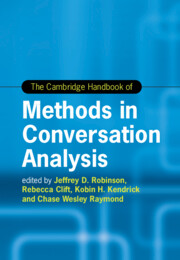Book contents
- Frontmatter
- Contents
- List of Tables
- List of Contributors
- Part I Introduction
- Part II Points of Departure
- Part III Collections
- Part IV Evidence
- Part V Avenues into Action
- 18 Single-Case Analysis
- 19 Ethnomethodology, Conversation Analysis, and the Study of Interaction in Everyday Life
- 20 Analyzing Categorial Phenomena in Talk-in-Interaction
- 21 Where the Action Is: Positioning Matters in Interaction
- 22 Analyzing Particles
- 23 Analyzing Grammar in Social Interaction
- 24 Listening to Talk-in-Interaction: Ways of Observing Speech
- 25 Multimodality in Conversation Analysis
- 26 System-Oriented Analysis: Moving from Singular Practices to Organizations of Practice
- 27 Comparing across Languages and Cultures
- 28 Methodological Considerations When Using Conversation Analysis to Investigate Institutional Interaction
- 29 Methods for ‘Applying’ Conversation Analysis
- 30 Using Conversation-Analytic Research Methods in the Study of Atypical Populations
- Part VI Situating and Reporting Findings
- Part VII Looking Forward
- Appendix I Jeffersonian Transcription Conventions
- Appendix II Multimodal Transcription Conventions
- Index
30 - Using Conversation-Analytic Research Methods in the Study of Atypical Populations
from Part V - Avenues into Action
Published online by Cambridge University Press: 06 December 2024
- Frontmatter
- Contents
- List of Tables
- List of Contributors
- Part I Introduction
- Part II Points of Departure
- Part III Collections
- Part IV Evidence
- Part V Avenues into Action
- 18 Single-Case Analysis
- 19 Ethnomethodology, Conversation Analysis, and the Study of Interaction in Everyday Life
- 20 Analyzing Categorial Phenomena in Talk-in-Interaction
- 21 Where the Action Is: Positioning Matters in Interaction
- 22 Analyzing Particles
- 23 Analyzing Grammar in Social Interaction
- 24 Listening to Talk-in-Interaction: Ways of Observing Speech
- 25 Multimodality in Conversation Analysis
- 26 System-Oriented Analysis: Moving from Singular Practices to Organizations of Practice
- 27 Comparing across Languages and Cultures
- 28 Methodological Considerations When Using Conversation Analysis to Investigate Institutional Interaction
- 29 Methods for ‘Applying’ Conversation Analysis
- 30 Using Conversation-Analytic Research Methods in the Study of Atypical Populations
- Part VI Situating and Reporting Findings
- Part VII Looking Forward
- Appendix I Jeffersonian Transcription Conventions
- Appendix II Multimodal Transcription Conventions
- Index
Summary
Conversations involving people with communication disorders or other forms of communicative impairment, such as those with dementia, autism, aphasia, or hearing impairment, differ in systematic ways from typical conversations (i.e., those involving participants without significant communicative or cognitive challenges). Drawing from CA work over the last few decades, this chapter discusses methodological issues involved in data collection in this field and in the transcription and analysis of these types of data. Analysis of the ways in which these interactions are distinctive and ‘atypical’ as regards social actions and the practices used in their construction and deployment involves a form of comparative analysis drawing on CA findings concerning typical interaction. The chapter also discusses other, more explicit, forms of comparative analysis regularly undertaken in this field, including comparison of participants’ conversations over time, and the comparison of how conversations involving participants with one type of communicative impairment compare with those of participants with a different form of impairment. One way in which the latter type of investigation can be developed is discussed in relation to a certain interactional feature – here, interruptive, other-initiation of repair – and how it may be traced across conversations involving participants with different communicative impairments.
- Type
- Chapter
- Information
- The Cambridge Handbook of Methods in Conversation Analysis , pp. 861 - 892Publisher: Cambridge University PressPrint publication year: 2024

